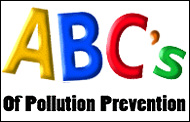 
Science and Technology - Biology
(ABC's of Pollution Prevention for Businesses)

for Small Businesses
Avoid chlorinated organic solvents, cyanide
compounds, and petroleum-based compounds when water-based substitutes exist.
Buy drainboards and drip pans to enhance drip
reuse in process baths.
Choose closed-loop (i.e., fully enclosed)
recycling designs to reduce wastes and worker exposures.
Decrease the frequency of painting and paint
removal to minimal levels.
Ensure a neat work environment to prevent spills
of toxic chemicals.
Foster a regular program of pollution prevention
planning and auditing.
Give employees incentives to find new pollution
prevention ideas.
Have and use covers for all containers holding
fluids that evaporate.
Instruct employees in pollution prevention.
Just use storage tanks with secondary
containment (i.e., double-walled tanks and a barrier around loading/unloading areas).
Keep track of toxic chemical inventories to
ensure fewer containers on-site, thus minimizing spills, spoilage, and evaporation.
Label containers to prevent mistakes that could
result in wastes requiring disposal.
Next Column Continue ~>
E-Mail Us: webshed@webshed.com
Date Modified:
Tuesday, July 03, 2001
Copyright©
1998 WebShed.Com |
Monitor and maintain the appropriate temperature
for heated materials.
Never allow leaks to persist.
Only use sprays when absolutely necessary, since
they waste chemicals through dispersion (e.g., paint overspray).
Preclean parts with physical methods (e.g.,
squeegees, rags) before using solvents.
Quit disposing of baths without checking bath
quality, and restore quality through the use of non-toxic additives.
Reformulate or redesign products so fewer toxic
chemicals are used in production processes.
Select continuous rather than batch processes
whenever possible, to avoid start-up wastes.
Try redesigning processes so they require fewer
toxic chemicals.
Use machines instead of manual methods where
toxicity concerns exist and process precision would reduce wastes significantly (e.g.,
paint spraying).
Varnish and other coatings that are not
essential should be avoided.
Wash parts only when absolutely necessary.
Xerox double-sided as often as possible.
Yield maximization is one goal, and...
Zero waste is the other.
Like our NEW page? Send Comments

visitors since Mar 30, 1999
 
|




